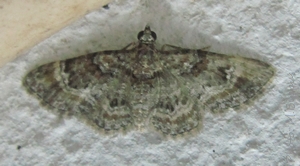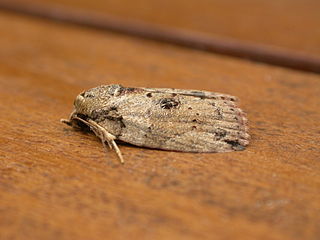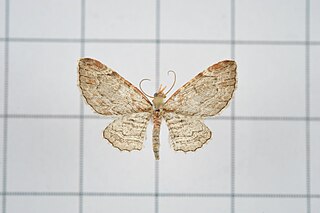
Aporandria is a monotypic moth genus in the family Geometridae described by Warren in 1894. Its single species, Aporandria specularia, was first described by Achille Guenée in 1857. It is found in Sri Lanka, India, Vietnam, Thailand, the Andamans, Peninsular Malaysia, Sumatra, Borneo, the Philippines and Sulawesi.

Gymnoscelis, the pugs, is a large genus of moths in the family Geometridae described by Paul Mabille in 1868.

Chiasmia emersaria is a moth of the family Geometridae. The species was first described by Francis Walker in 1861. It is found in India, Nepal, northern Thailand, China, Sri Lanka, Japan and the Ryukyu Islands.

Eucyclodes gavissima, the Oriental orange banded green geometer moth, is a species of moth of the family Geometridae described by Francis Walker in 1861. It is found in the Indian subregion, Sri Lanka, Bhutan, western China, Taiwan, Vietnam, Sumatra and Borneo.

Nanaguna breviuscula, the pigeonpea pod borer, is a moth species of the family Nolidae. It is found from Sri Lanka and India east to Samoa. In Australia it is found in the Kimberleys in Western Australia, the northern part of the Northern Territory and from the Torres Strait Islands and Queensland to Sydney in New South Wales.
Glaucoclystis immixtaria is a moth of the family Geometridae described by Francis Walker in 1862. It is known only from Sri Lanka, the Chagos Archipelago, Queensland and Fiji. It could prove to be more widely distributed, with populations in more seasonally dry habitats such as Java and the Lesser Sunda Islands.

Calluga costalis is a moth of the family Geometridae. The species was first described by Frederic Moore in 1887. It is found in Sri Lanka, Taiwan, Borneo, Bali, Sulawesi, Seram, New Guinea and Queensland.

Gesonia obeditalis is a species of moth of the family Noctuidae first described by Francis Walker in 1859. It is found from eastern Africa, the Seychelles, the Maldives and the Oriental tropics of India, Sri Lanka east to the Philippines, the Sula Islands and Australia. The adult moth has brown wings with a scalloped dark brown band near the margin. The hindwings are similar in pattern to the forewings but are a paler shade of brown.

Eupithecia costalis is a moth in the family Geometridae first described by Francis Walker in 1863. It is widespread in the tropical and subtropical lowland regions of east and south-east Asia, from Taiwan to India, Sri Lanka Borneo, Borneo, to Hong Kong.
Ziridava xylinaria, the indistinct carpet, is a moth in the family Geometridae. The species was first described by Francis Walker in 1863. It is found in Sri Lanka, India, Hong Kong and on Peninsular Malaysia, Borneo, Java and possibly the Philippines and Sulawesi.
Gymnoscelis admixtaria is a moth in the family Geometridae. It was described by Francis Walker in 1862. It is found in Sri Lanka, India and Japan.
Eriopithex recensitaria is a moth in the family Geometridae first described by Francis Walker in 1862. It is found in Sri Lanka, Taiwan, on Borneo and in the Australian state of Queensland.
Gymnoscelis tibialis is a moth in the family Geometridae. It was described by Frederic Moore in 1887. It is found in Sri Lanka and on Java.

Gymnoscelis tristrigosa is a moth in the family Geometridae. It was described by Arthur Gardiner Butler in 1880. It is found from Sri Lanka and Taiwan to Fiji, Tonga and New Caledonia.
Gymnoscelis deleta is a moth in the family Geometridae. It is found in India, Korea, Japan, Taiwan and probably in Sri Lanka according to Hampson.
Gymnoscelis ectochloros is a moth in the family Geometridae. It was described by George Hampson in 1891. It is found in India and Sri Lanka according to Hampson.

Eois grataria is a moth in the family Geometridae. It is found in the Indian subregion, Sri Lanka, Hong Kong, Sundaland and on Christmas Island.
Culladia admigratella is a moth in the family Crambidae. It was described by Francis Walker in 1863. It has a wide range in the tropics, and has been recorded from the British Indian Ocean Territory, Kenya, Malawi, Mauritius, Nigeria, the Seychelles, Sierra Leone, Socotra, India, Myanmar, the Philippines, Sri Lanka and Sumatra.
Surattha invectalis is a moth in the family Crambidae. It was described by Francis Walker in 1863. It is found in Sri Lanka, India, Java, Indonesia, Myanmar, and Kenya.

Hyposidra talaca, the black looper or black inch worm, is a moth of the family Geometridae. The species was first described by Francis Walker in 1860. It is found from India to Indochina, Sundaland, Sulawesi, the Philippines, Sri Lanka, the Solomon Islands, Thailand, Taiwan, New Guinea and Australia, where it has been recorded from Queensland. It is a major defoliating pest in tea plantations.










